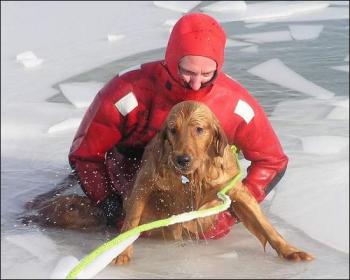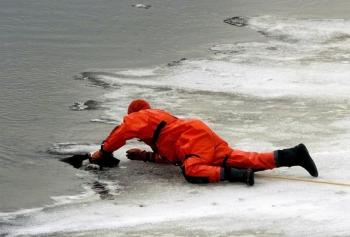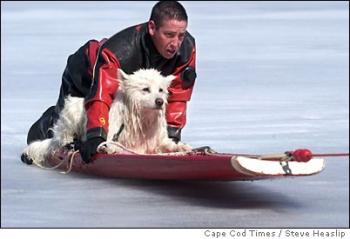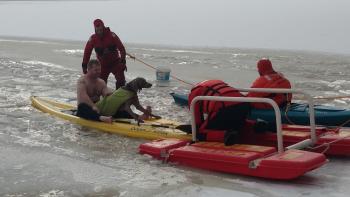The Need for First Responders to be Trained and Equipped to Perform Domestic Animal Rescues
by Gerald M. Dworkin
February 06, 2008





Based on our research of ice rescue incidents and fatalities during the years 2006 & 2007, approximately 85% of the incidents were initiated as a result of humans venturing out onto the ice to rescue a domestic animal. The purpose of this article is three-fold. First, we need to educate the public about the need to control their pets and to prevent them from going out onto the ice because no ice should ever be considered as being “safe ice”. Second, we need to also educate the public to call 911, rather than to make an attempt to rescue their pets that have fallen through the ice. And, third, First Responder agencies and their personnel need to be trained and equipped to properly, effectively, and safely respond to domestic animal rescues on and through the ice.
NFPA 1670: Standard for Technical Rescue
In February 2004, the National Fire Protection Association (NFPA) published NFPA 1670: Standard on Operations and Training for Technical Search and Rescue Incidents. The purpose of this standard is to minimize threats to rescuers while conducting operations at technical SAR incidents. This standard deals specifically with identifying and establishing levels of functional capability for conducting technical rescue operations safely and effectively. Although these standards were designed for all types of Technical Rescue operations, they also address water and ice rescue operations.
These standards are intended to assist the Authority Having Jurisdiction (AHJ) to:
- Assess the technical rescue hazard within their specific response area;
- Identify the level of operational capability needed; and
- Establish operational criteria.
As a responder to technical rescue incidents, the AHJ needs to determine the level of response the authority is compelled to provide. The AHJ must then plan for it, train for it, and allocate the necessary resources to manage the appropriate response at that level.
According to NFPA 1670, the AHJ shall establish levels of operational capability needed to conduct operations at technical SAR incidents safely and effectively, based on hazard identification, risk assessment, training level of personnel, and availability of internal and external resources. This standard also advocates the establishment of written Standard Operating Procedures (SOPs) consistent with one of these operational levels:
- Awareness level: represents the minimum capability of organizations that provide response to technical SAR incidents.
- Operations level: represents the capability of organizations to respond to technical SAR incidents, and to identify hazards, use equipment, and apply limited techniques specified in this standard to support and participate in technical SAR incidents.
- Technician level: represents the capability of organizations to respond to technical SAR incidents, and to identify hazards, use equipment, and apply advanced techniques specified in this standard necessary to coordinate, perform, and supervise technical SAR incidents
Once the operational level has been identified, the AHJ shall establish operational procedures consistent with the identified level of operational capability to ensure that technical SAR operations are performed in a manner that minimizes threats to rescuers and others. Once the appropriate level of operational capability has been determined, the AHJ must then provide for training in the responsibilities that are commensurate with the operational capability of the organization, and provide for the continuing education necessary to maintain all requirements of the organization’s identified level of operational capability.
In order to meet the organization’s identified level of operational capability, in addition to developing SOPs and providing necessary training for its personnel, the AHJ must ensure that equipment commensurate with the respective operational capabilities for operations at technical SAR incidents and training exercises is provided.
Domestic Animal Rescue
Many First Responder organizations have established policies that prohibit their personnel from responding to domestic animal rescues due to the inherent risk and danger posed to their personnel. However, it must be realized that if trained professional rescue personnel don’t respond, then the public will do so at great risk to themselves. And, in doing so, the incident can escalate from an animal at risk of drowning to a human victim or multiple victim incident at risk of drowning.
In order for First Response agencies to safely and effectively respond to any type of cold water and/or ice rescue incident, the First Responders must be appropriately trained for this type of incident, and they must have the appropriate Personal Protective Equipment (PPE). This should include an appropriately designed Ice Rescue Suit with integrated gloves, rigid sole boots, hood, and harness system. Other PPE equipment could include a helmet, cleats, and ice awls. In addition, the rescue personnel must be tethered to shore at all times with line that is specifically designed for use in water and/or on ice.
In addition to this equipment, any rescue personnel venturing onto the ice or into the water to rescue an animal should also be equipped with an animal control pole. The purpose of the pole is to allow the rescuer to safely snare the animal and to restrain the animal while keeping the animal at a safe distance away from the rescuer and/or his/her equipment.
The Ketch-All Company has been manufacturing qualify animal control equipment for over 50 years. According to their company, their goal is to provide the animal handling professional with the highest quality, safest & cost-effective restraint pole on the market. For information on their company and products, visit their website at www.ketch-all.com.
Lessons Learned: Dog-rescuing hero picks up infection from dog bite
On December 13, 2007, John Smith a New Jersey Firefighter, responded with his Fire Company to a detention pond for a report of a dog that had fallen through the ice. Upon arrival on the scene, Firefighters Smith and Roberts sledded onto the ice and made their way to the hole where Skipper, a black Labrador, was paddling in the frigid water. As the firefighters scooped the dog out to rescue it, Skipper bit through Smith’s gloved left hand, penetrating the skin. Firefighter Smith suffered a broken finger and the bite allowed contaminated pond water to seep into the wound, causing an infection.
As a result of this incident, Firefighter Smith has been out of work for the past six weeks. Although the doctors set the break, because of the infection Smith has been on antibiotics ever since, getting as many as four intravenous treatments a day for three weeks. On top of all that, Firefighter Smith also developed a case of the Shingles which he believes was caused by the stress the injury caused on this body. Smith is a professional firefighter and works part-time as a Fire Inspector for a smaller department, and also is an instructor at the state Fire Academy. For the six weeks, he’s not been allowed to perform any work until the doctors clear him.
Ice Rescue Training
The focus of any ice rescue training program should be to prepare rescue personnel to safely and effectively respond to incidents on and through the ice. Training in personal safety and survival skills should be paramount. Rescue skills should include the use of a variety of equipment, procedures, and techniques and should include rescue protocols for active, as well as passive victims; the management of suspected spinal injuries; and domestic animal rescue.
Summary
Public Safety and Rescue agencies need to pre-plan ice and water rescue incidents, and personnel need to be appropriately trained to safely and effectively respond to incidents on and through the ice. Collaborative discussions and pre-planning should also be conducted with the community animal control officers. Humane Society representation can also be brought into the loop. Besides the appropriate Personal Protective Equipment needed for water and ice rescue incidents, First Responder agencies should also obtain animal control poles to prevent the animal from compromising the equipment or safety of the rescue personnel.
______
This article was published in the November 2008 issue of Fire Chief Magazine at:
http://firechief.com/rescue/pets_peril_1108/index.html?smte=wr
_______________________
This article was posted by the Associated Press on January 22, 2010
Los Angeles Firefighter Hospitalized After Rescuing Dog
Friday , January 22, 2010
*********************************
LOS ANGELES —
A German shepherd hoisted to safety from the storm-swollen Los Angeles river Friday is fine, authorities said, but the firefighter who splashed down in the daring helicopter rescue was hospitalized after being bitten by the dog.
Joe St. Georges, a 25-year department veteran, suffered severe hand and arm injuries but was in good condition at County USC Medical Center Friday, said Los Angeles fire Capt. Steve Ruda.
“He has significant injuries, bites and punctures, to his hand and arm and is being seen by a specialist,” Ruda said.
The dog, nicknamed Vernon after the Southern California town where he was found, did not have a name tag or computer chip, said Sgt. Charles Miller of the Southeast Area Animal Control Authority in Downey.
The dog was quarantined to be monitored for rabies, but “appears to be well-maintained and cared for,” Miller said.
At least 50 firefighters responded to reports that the dog was in the river. For an hour, firefighters stood at the top of the steep, concrete banks, throwing life vest and float rings, hoping the dog would grab on. Most of the time, the canine walked along a pipe or ledge in the center of the river, sometimes slipping. One firefighter got into the river and tried to catch him, but the dog took off. Soon the pipe was submerged.
When the helicopter hovered overhead, the dog scrambled to the side of the river and tried to climb the sides, only to slip each time.
The 50-year-old St. Georges finally splashed down from the helicopter, wrestled with the frightened canine and lifted it to safety.
At a late afternoon news conference, helicopter pilot Scott Bowman said St. Georges took a muzzle with him but he wasn’t able to get it on, “so he decided to go for the capture.”
Miller said the dog had some scrapes and worn nails, but was otherwise fine.
“He was fearful when he first got here, understandably. He went through a big ordeal,” Miller said.
The dog will be quarantined for 10 days, unless the owner shows up with proof of rabies vaccination, Miller said. Then, the dog could be monitored at home. If the owner doesn’t show up, officials will try to find the dog a new home.
Storms that started Monday have already dropped up to 8 inches of rain in Los Angeles County, the National Weather Service reported.


